It was early morning in Bagan and I was climbing down the roof-top of our hostel, where I had just fetched my laundry from the washing machine. On my way down I overheard a short exchange of words between two obviously freshly arrived guys from Germany, who themselves were climbing up to throw their groggy bodies on the day beds: Haben wir Wasser dabei?… Nee. … – Scheiße… Zähne putzen.
I was smiling a bit inside. I have not used tap water for tooth brushing since I have left Vienna, and I have got very much used to regularly collecting drinking water from the water dispensers, which are contributing to providing safe water and reducing plastic waste in many places in Asia now.
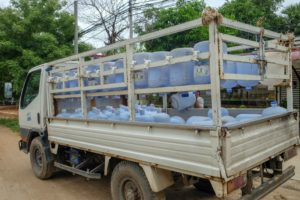
After 2 months of travelling I am still a newbie, but slowly progressing to Level 2 in longer-term travelling, and have developed some useful habits and daily routines for life in Asia. Nontheless, I have changed my address from Indonesia to Myanmar some days ago, and changing country means practically starting from Zero again. I chose to go there for the month of October, as the rainy season is about to end, not yet high season and everything should be lush and green.
You always start as a super-tourist in the first few days. I have no clue how a new place works. What is the most hassle-free way to order a taxi? Are prices quoted to foreigners realistic or too high – and if so, how much too high? Where can you bargain and where not? What are cultural aspects you need to be aware of, do’s and don’ts? I don’t know a single word of Burmese – neither Hello, nor Please or Thank you. Good start.
On Oct 3 I flew from Jakarta to Yangon, the flight from Jakarta to Bangkok takes 3 hours and another hour from there to Yangon. This is a shorter distance than flying from one end of Indonesia to another. Just for comparison, the distance Medan (Sumatra) to Yangon (Myanmar) is 1.500kms as the crow flies, whereas the distance Medan – Manado, both Indonesia, is twice as long with 3.000 kms.
You are in Asia and might be tempted to think it’s all a bit similar anyway. And then you get on board of a plane, cross borders, change visa – and suddenly things are and feel VERY different. Different country, different game. Here are my impressions after my first days in Myanmar – and inevitably some undue comparisons with my first home country in Asia – Indonesia.
Myanmar – what crosses your mind?
Aung San Suu Kyi? Yes, she is omnipresent. Her picture and press-clippings hang in small cubes, where women sew clothes, on the markets. Her portrait is painted on a table in our guesthouse. Suu Kyi is the iconic leader of the Myanmar’s democracy movement, Nobel Peace Prize winner, and as State Counsellor de facto leader of Myanmar today. Her government has recently also drawn also a lot of criticism in dealing / or not dealing with the conflict and human rights violations against the Rohingya people.
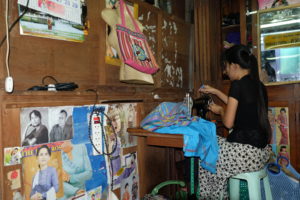
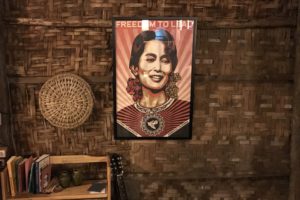
Conflicts between ethnical groups, history, temples, trekking? Yes, all of it.
Myanmar looks a bit like a balloon on a string, stretching North-West of Thailand, touching China, Bangladesh and India in the North, and with a long coastline to the Gulf of Bengal and the Andaman sea in the West. Looking at some key socio-economic data for this 52 million people country I expected to encounter a very poor country with things much worse in many aspects than in Indonesia.
Myanmar is one of the poorest nations in Southeast Asia. Around 30% of people live in poverty, although this proportion has been reduced dramatically from 48% in 2005. Democratization, socio-economic policies, a lot of international aid money and vast infrastructure support programs have resulted in strong, but still very vulnerable economic growth.
On a very profane level, arriving in Yangon, I expected a similarly chaotic and dirty city, as I have encountered in much of Indonesia. However, driving from the airport into Myanmar’s biggest city with over 5 million inhabitants – the first glance was quite different from my imagination. I passed by furniture shops, which could as well be standing in Northern Italy, inside and out. Traffic is busy, but orderly, taxi drivers ask you to wear a seat belt in the back. No motorbikes are allowed in the center. In many places you see much less garbage and dirt, although wandering home at night we encountered rats of all sizes running across the sidewalks in some areas.
From what I have seen until now, Myanmar also seems to have a better waste management (well, to be honest, possibly any waste management system and behavior will be better than in Indonesia), I have seen plastic free campaigns in various places. In Bagan you can rent e-bikes to explore the temple area, which is positive at least from a local environmental and health perspective.
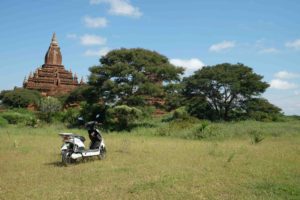
Religion plays a much bigger role in public and many people’s private lives in South-East Asia, when compared to Middle Europe.
88% of Myanmar’s population are Buddhists, with Theravāda Buddhism also being the state’s preferential religion. Many ethical conflicts are also based in religious differences, and access to army or government jobs is practically impossible for non-Buddhists.
Monks and partially also nuns are a normal part of street and town life, much more than in other Asian countries I have visited so far. Every morning a young monk was standing in front of my hostel, silently waiting to collect a banana or another form of charitable donation.
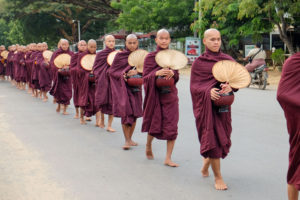
Myanmar and Indonesia: 2 completely different shapes of friendliness
My first impression of Myanmar is that people are very friendly, however – comparing to Indonesia – more reserved and discrete. Somebody told me that in Buddhism, you would rather do or say nothing, than offend someone.
I am no sociologist, cultural anthropologist, or other type of expert, which would eventually allow me to make generalized statements, but I can offer to tell some personal stories. In doing so I really hope not to step on anyone’s toes, especially not friends’ in the countries I have visited. I am aware that it is a clumsy view of an outsider, who tries to see, sense and observe without making any judgements. It is through MY eyes, and therefore subjective. If you disagree somewhere, please let me know and hopefully it’s the start of an interesting, careful exchange. Terima kasih! ကျေးဇူးတင်ပါတယ်!
In Indonesia I encountered a friendly, open curiosity across the archipelago. In general, it took only a few moments to exchange the most important key data: name, origin, family situation, kids, where from, on the way to, what are you currently doing, where are you going, are you married – and in my case, why on earth, not?! It is very important that people can place you in the universe, as Elizabeth Pisani says in her wonderful book >Indonesia etc.< And so – she goes on saying – “I told them about my imaginary husband, about my non-existent job, about my parents’ village.”
She also describes how important it is that you belong somewhere. “One of the most important functions of [social] rituals is that they tie people into their place in the local cosmology, ensuring that everyone knows where they, and everyone else, fit.” You cannot just be a solo female traveller, roaming around all on your own. This is inconceivable, a fable animal for many Indonesians.
I have encountered this importance of belonging somewhere, of being a member of a ‘clan’ in many places in Indonesia. Even as a stranger, it does not take long, until you are somehow part of a community, are adopted in a very unintrusive way.
Personally, I liked this subtle caring for each other, belonging to a small group, being part of it – without the obligation to stick closely – a lot.
On Bunaken island I belonged to our resort. Our dive masters always knew by and large where their flock were and if we were OK. I could hire a motorbike just by saying I’m diving with Vanus. No name, no paperwork, no details. You pay the agreed rental fee, get handed over the keys and the bike, and that’s it. Identification and proof of creditworthiness by association to a clan.
In in the jungle village Ketambe I was sitting next to the river, and just wanted to be alone for a while. But friendly, noisy kids checked by, guides stopped, wanting to attract me as a client. Nobody could understand that I just wanted to sit on my own and stare into the flowing water. But if I told them, that I stayed in Orangutan guest house and went trekking with Putra, it was clear where I belonged, and everybody seemed to be fine with that – at least they did not put me in the box of complete lunatics anymore.
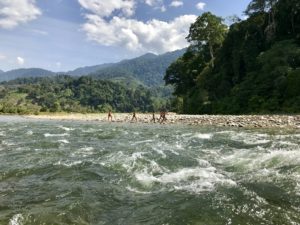
In Myanmar, I have not yet experienced something comparable up to now. Until now I have not received a personal question from a local, not even if their English is good. You are respected as a tourist, in some places clearly as someone who brings money (which is the same in Indonesia in tourist hotspots of course), but it seems that people keep more distance.
I had a funny encounter on my first day in Yangon, when is suddenly started to rain cats and dogs and I was seeking shelter under a tree in a park. On the street outside there were 2 personnel carrier vehicles of a private Myanmar police. One of the men signaled, if I wanted to protect my phone by waiving with a plastic bag, which I answered with hand and feet: Not my bag, but if I could myself get some shelter that would be wonderful and ran over. They welcomed me under the plastic canvas, smiling friendly. Used to Indonesian conversation style and as the rain did not seem to stop, I tried to start a bit of a talk, gesturing, but was quite unsuccessful. I ended up sitting there quietly for some 15 minutes, said a polite Thank you as the rain stopped and left again. They did allow me to take a picture, so here it is, especially for you:
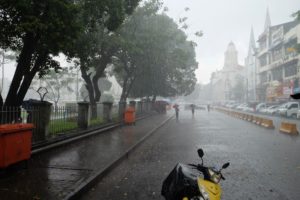
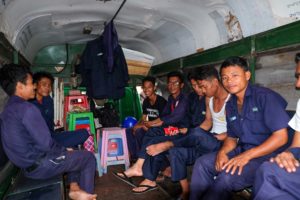
Humor is another aspect that differs a lot. Changing countries, you have no clue yet, what makes people feel at ease or laugh. In every language there are some useful words or expressions, which make people laugh, especially if you try using them as a visitor. What are these small triggers, where you are not only seen as another tourist, but your vis-à-vis suddenly looks into your face and starts smiling? I know a tiny little bit of it for Indonesia, but I have no idea about Myanmar, not even if humor is an important social glue here?
In 7 weeks in Indonesia, I caught a few expressions, and I find myself continuing to translate conversation pieces into the few chunks of Bahasa Indonesia I know. Two days ago I said good-bye to a guy in one of the many temples around Bagan, and he responded langsam-langsam in German. I laughed and without thinking I replied pelan-pelan in Bahasa, leaving the poor fellow a bit lost.
So again, I try to find small opportunities to make contact without words: I sit down on the warm stones in a temple, play with a cat and suddenly a family with small kids is by my side, an old woman smiles at me. The great thing in Myanmar’s markets is that I have never seen about 1 in 4 products on display before. I ask what things are, am being offered new veggies, fruits or a salad to taste.
I eat in a street restaurant, sitting down at the low plastic chairs next to locals. The person next to me hands over all the sauces and spices, shows me were to put it, proudly warns me if something is super-spicy that I as a foreigner should better not taste. A well-fed vendor passes by, signals thumbs up, notices that I eat raw okra (normally I don’t like them, but incredible – they are way better raw than cooked until slimy!), and he places another small plastic plate full with green stuff in front of me. He grabs a frail plastic chair, sits down and starts a conversation – he without speaking a word of English, me without understanding a single word of the Burmese sing sang. It works. How nice!
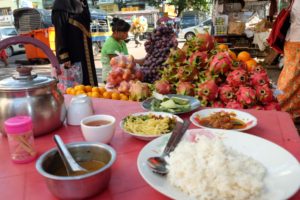
If I had to describe Myanmar with just one word it would be: GRACE. Grace seems to be engrained everywhere and in everything they do in an inartificial matter. Bougainvillea and huge cacti are planted in front of temples, flowers and beautiful trees frame century old stupas. Goods displayed in the street markets are carefully arranged on newspaper and banana leaves. Everything contains an aspect of beauty and elegance, without being decorated, more in a Feng Shui kind of way.
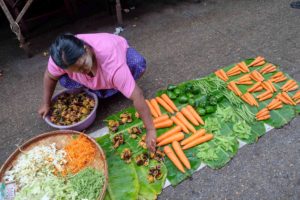
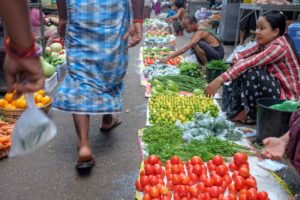
The most important piece of clothing for men and women alike is a longyi, a sheet of cloth worn around the waist, mostly down to the ankles. Also in Yangon it is worn by the majority of men, also in business and offices, often combined with perfectly ironed white shirts. Cultivated, well-groomed and graceful. I cannot say otherwise.
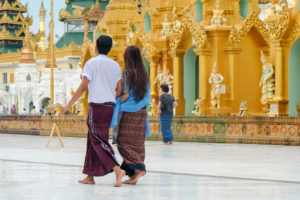
When you enter a Buddhist temple it is required to take off your shoes, and in the ones which are still actively used as a religious site it is also required to wear a long skirt or trousers covering your legs, ideally a longyi. I carry a big, light yellow scarf from Marrakech with me for that purpose – it’s a phantastic multi-cultural piece, which I use as a shawl to cover my head in islamic countries, or wrap it around me as a long skirt in Buddhist temples. Entering the Shwedagon pagoda in Yangon, I wanted to do my usual trick, but the lady behind the counter came out and gave me a hand in wrapping it around me properly. After a while she shook her head, it was clear, that she was not satisfied with the outcome and asked me if I had something else. I had – a violet longyi, which I had just bought on the market a few minutes ago. She nodded appreciatory, took it out of my hand and started to get me dressed. After minutes of twitching, stretching and dragging, while politely avoiding comments about my waist/hip-ratio, she was finally pleased with the result, smiled contentedly at me and allowed me to enter the pagoda with a subtle inviting gesture of her right hand. Only in Myanmar!
Until now – and this is an important disclaimer – I have only visted Myanmar’s largest city Yangon and one of its most important cultural hotspots, Bagan. It is therefore only a small window, through which I peeked into this huge country. I am curious to see more of it in the weeks to come, whereas I am already sure of two things: Myanmar will be a dream from a culinary and photographic perspective.
Meanwhile I speak my first word of Burmese – Mingalabar – which is a sort of Hello and easy to remember if you spend an evening in front the sign of the „Mingala Bar“ at our guesthouse. Seems like a good start to go out exploring.

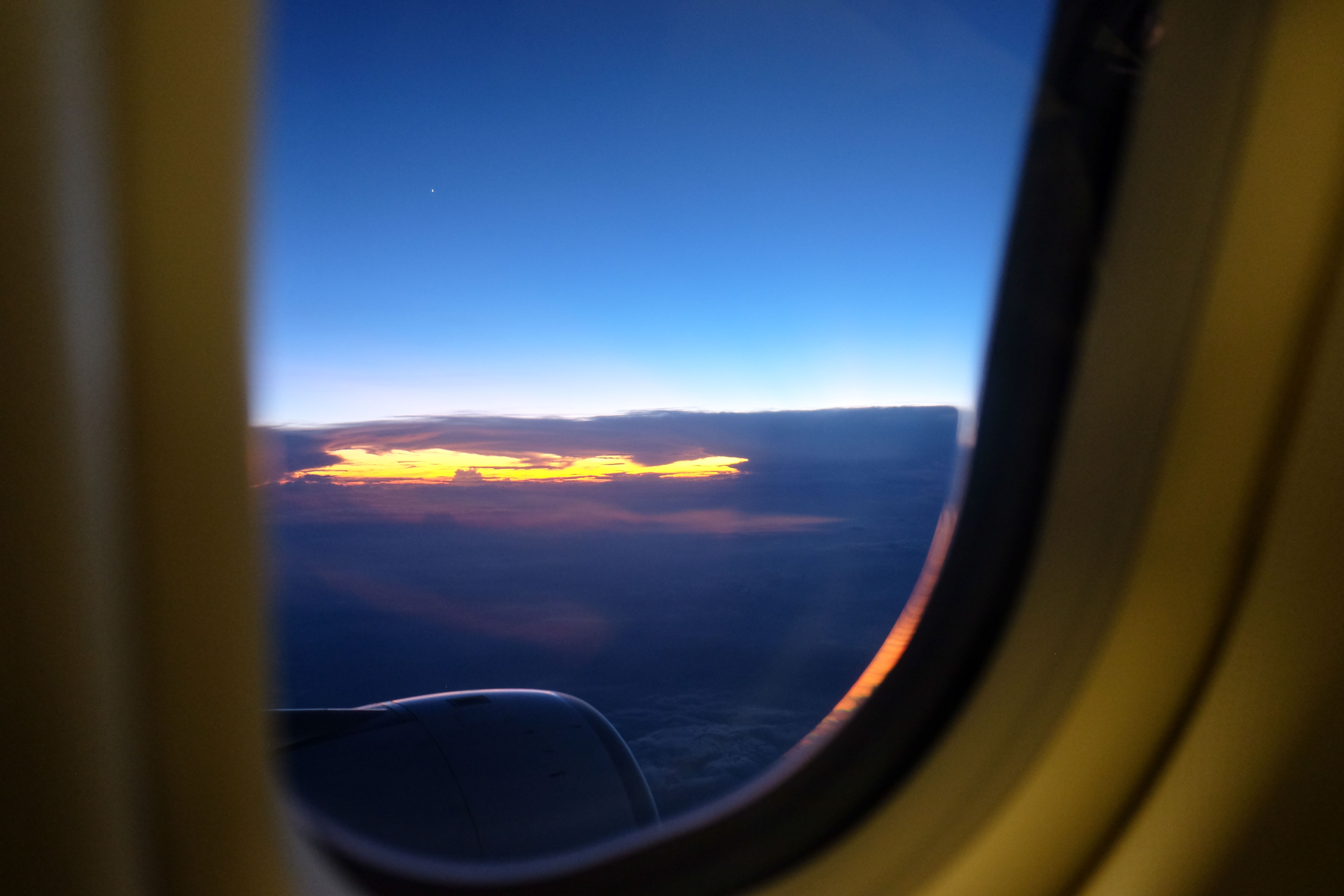

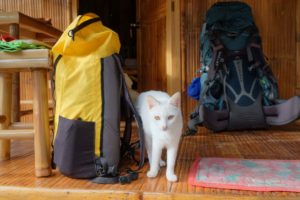
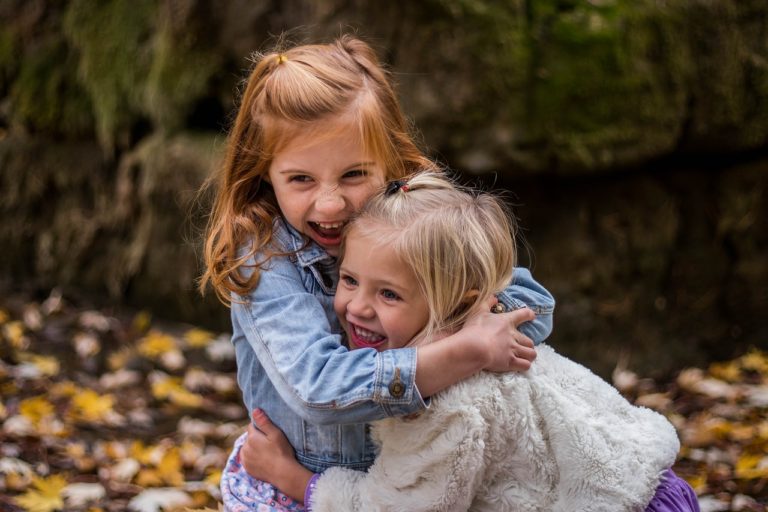
Märie Radaschitz
15 Oct 2018Mangalabar liebe Tina!
Mit einem Lächeln auf meinem Gesicht las ich deine Zeilen über Humor..und was es ist das Menschen Lächeln..lachen..
Ich bin mir sicher du schaffst es überall auf der Welt Menschen zum Lächeln zu bringen:)
Lieben Gruss …💚, Ja richtig!😊🌼
Andrea
11 Oct 2018Wieder mal ein toller Artikel, der zum Reflektieren anregt. Was mir von meinen eigenen Reisen so bekannt vorkommt – das Vergleichen – ist Segen und Fluch gleichzeitig. Denn ich finde, dass die Wahrnehmung dadurch viel einseitiger wird. Man wendet unbewusst seine ganz eigenen „KPIs“ an und kommt vielleicht gar nicht auf die Idee, dass es in einem neuen Land ganz andere KPIs geben könnte – oder sollte. Wie oft habe ich an den traumhaftesten Orten, wenn ich begeistert meinte, dass mich grad irgendwas an meine Lieblingsstadt Sydney erinnert, die Frage gehört: „Wenn du alles nur an Sydney misst, warum reist du dann überhaupt woanders hin?“ Die genaue Antwort auf diese Frage kenne ich noch nicht, aber ich weiß, dass das Reisen manchmal für mich einfacher gewesen wäre, wenn ich keine Vergleiche angestellt hätte. Gleichzeitig weiß ich aber auch, dass das Nichtvergleichen eine Kunst ist, zu der ich trotz aller Bemühungen einfach keinen rechten Zugang finde. Wenn du herausfinden solltest, wie das geht, bitte um eine Schritt-für-Schritt-Anleitung für geneigte, aber sehr unbegabte Anfängerinnen.